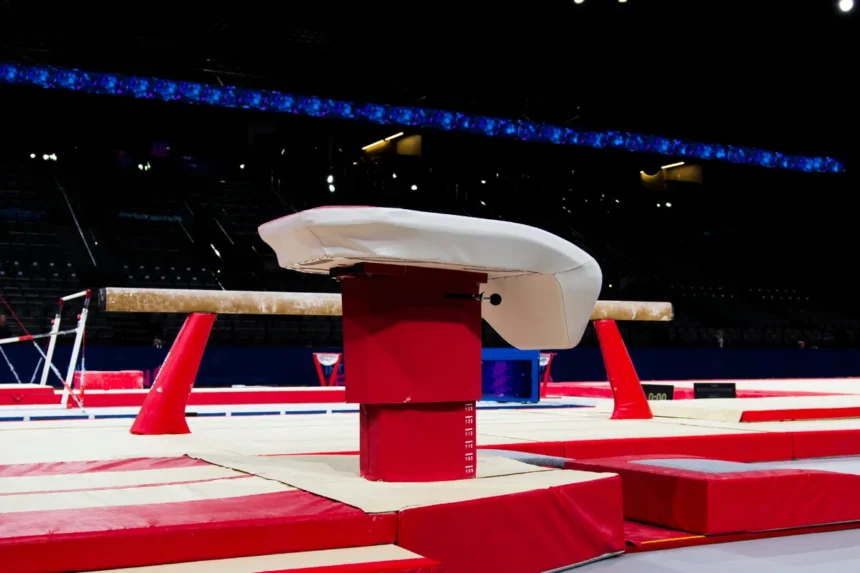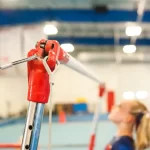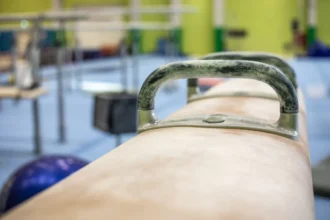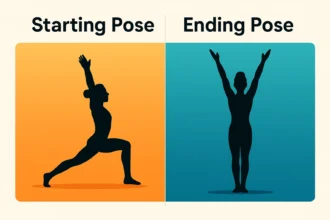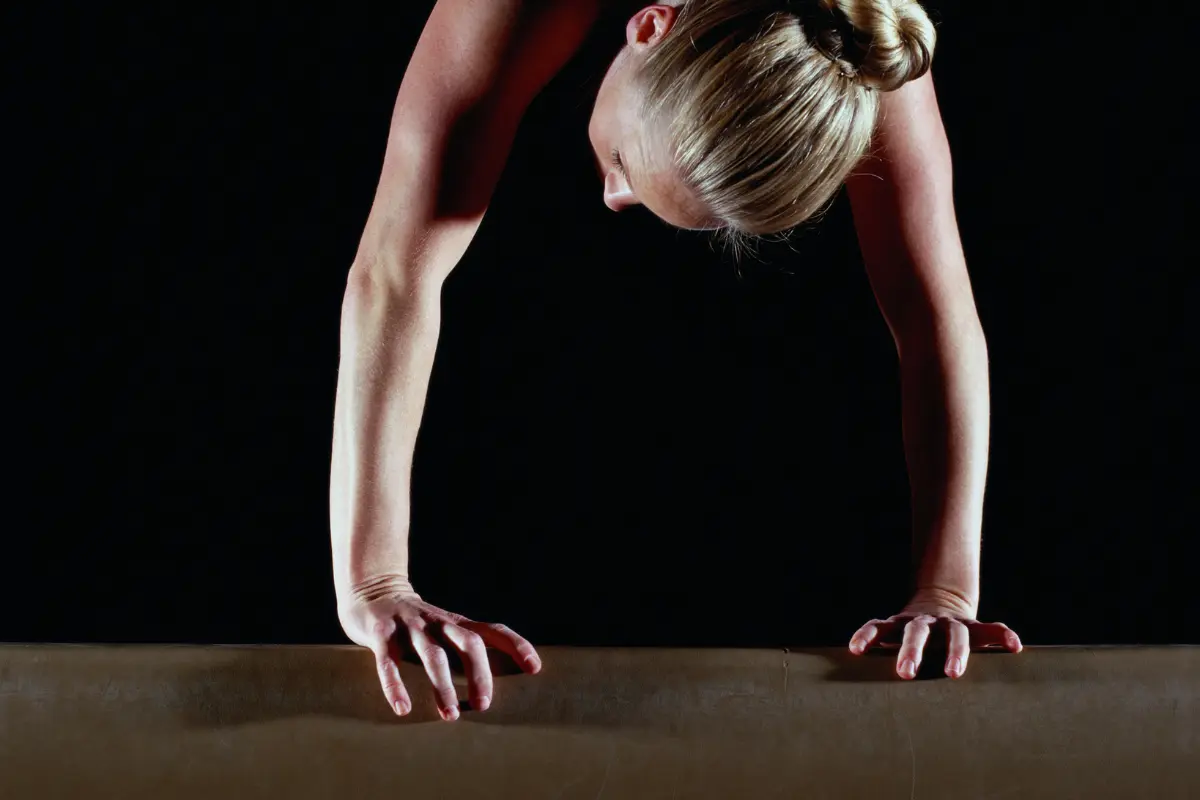Vault is one of the four events in women’s artistic gymnastics. It may be the shortest routine, often just a few seconds, but it’s also one of the most powerful and exciting. Each vault begins with a fast run and ends with a big jump, a flip or twist in the air, and a strong landing.
The Vault Setup: What Equipment Is Used?
The vault event uses several key pieces of equipment:
- Runway: A long, carpeted track (about 82 feet) where the gymnast builds speed with a strong sprint.
- Springboard: A small, spring-loaded board placed at the end of the runway. It turns horizontal speed into vertical lift.
- Vault Table: A padded, curved platform that stands about 4 feet tall. The gymnast places her hands on the table and pushes off—this is where the “block” happens. It replaced the older, narrower vaulting horse used in the past.
- Landing Mat: A thick, soft mat where the gymnast is expected to land upright, with control and stability.
At lower levels, especially in Levels 1–3, the vault table is often replaced with a stacked mat or trainer block to match the gymnast’s age and skill level. As athletes progress, they transition to using the full vault table at standard height.
What Are Judges Looking For?
In vault, gymnasts are scored out of 10.0 based on:
- Start Value (SV): The maximum score for the vault (depends on the vault performed).
- Execution (E-score): Up to 10.0 points; deductions are taken for poor form, bent arms, legs apart, piking, bad posture, and uncontrolled landings.
- Neutral Deductions: Taken for things like stepping out of bounds, coach spotting, or going over time.
Unlike floor and beam, there’s no dance, music, or choreography, just pure athletic performance.
Vault Requirements by Level (USAG Women’s Gymnastics)
Now that you know how the vault works, let’s look at what skills are required at each level. The USAG Development Program breaks vault down into a step-by-step progression, starting with basic shapes and leading up to advanced flipping and twisting vaults.
Below is the full progression from Level 1 to Level 5.
Level 1 Vault
Skill: Stretch jump onto mat stack → Kick to handstand → Fall to flat back
Level 1 vault is where gymnasts are first introduced to the essential elements of vaulting: a fast approach, strong takeoff, and controlled body movement through the air. In this skill, the gymnast sprints toward the springboard, performs a stretch jump onto a low mat stack (about 16 inches high), then kicks up to a handstand and finishes by falling flat onto their back in a tight, straight position.
- Mat Height: Approximately 16 inches
- Primary Focus: Body alignment, a strong kick to vertical, and a safe, clean fall
- Purpose: Builds confidence in basic inverted positions and teaches correct handstand shaping and landing mechanics
Coaching Tip:
To build confidence and clean shapes, coaches often split the skill into two parts:
- Stretch jump drills: From springboard to stacked mats
- Handstand fall drills: Practiced on floor or soft incline mats
Mastering this foundation sets the tone for all vault progressions ahead.
Level 2 Vault
Skill: Run → Hurdle → Jump to handstand on raised mat stack → Fall to flat back
The Level 2 vault builds directly on Level 1 by increasing the height of the mat and adding a running approach. After a hurdle and punch on the springboard, the gymnast jumps into a handstand on a raised mat stack and then falls to their back in a tight body position.
- Mat Height: Approximately 32–48 inches (depending on athlete height and gym setup)
- Primary Focus: Improved handstand position, more aggressive punch from board, body control through the fall
- Purpose: Encourages strong pre-flight and block awareness while maintaining correct body tension during inversion
Coaching Tip:
Focus on:
- Run mechanics: Use floor sprints to build power
- Vertical handstand kick: Reinforce using handstand shaping drills against a wall
- Flat back landings: Add targets to ensure tight body position and consistency
This vault helps gymnasts learn how to transfer energy from the board through their hands and into upward motion.
Level 3 Vault
Skill: Run → Hurdle → Jump to handstand on vault-height mat stack → Fall to flat back
At Level 3, the gymnast must now perform the same handstand flat back skill onto a mat stack that simulates the height of a competition vault table. This level introduces more height and demands stronger repulsion and tighter form.
- Mat Height: Approximately 100 cm (or regulation vault table height)
- Primary Focus: Straight body line, quick and strong block off hands, higher and longer flight phase
- Purpose: Prepares athletes for handspring vaults by training shoulder extension and controlled repulsion
Coaching Tip:
Break the vault into phases:
- Pre-flight: Use springboard drills to improve height and distance
- Block phase: Practice shoulder pop drills on panel mats or foam blocks
- Flat back landing: Mark landing zones to help athletes control distance and body line
This level is the first true preparation for vaults that will be performed over the table in Levels 4 and 5.
Level 4 Vault
Skill: Run → Hurdle → Front handspring over vault table → Controlled landing
The Level 4 vault is a major milestone. Gymnasts now perform a front handspring over the actual vault table. The goal is to create powerful forward rotation using proper arm position, shoulder block, and tight-body form.
- Table Height: Approximately 115 cm for ages 9+ (adjusted for younger athletes as needed)
- Primary Focus: Strong block from the table, tight body in flight, safe landing in control
- Purpose: Introduces the core vault used in optional gymnastics; builds foundation for twisting and flipping vaults
Coaching Tip:
To develop this skill:
- Use vault timers: Practice handspring to flat back on mats stacked behind the table
- Refine approach run: Sprint drills help with acceleration and posture
- Block drills: Teach shoulder drive using handstand pops and snap-down rebounds
Proper hand placement and shoulder mechanics are essential to protect the wrists and develop height and rotation.
Level 5 Vault
Skill: Run → Hurdle → Front handspring over vault table → Controlled landing (same skill as Level 4, judged more strictly)
Level 5 uses the same vault as Level 4 — a front handspring over the vault table — but now expects more polish, power, and form. Judges apply stricter criteria and expect higher amplitude, tighter shapes, and more consistent landings.
- Table Height: Standard competition height (typically 115 cm)
- Primary Focus: Increased flight time, stronger repulsion, stuck or lunge-controlled landing
- Purpose: Final compulsory-level vault, preparing athletes for optional vaults like Tsukaharas and Yurchenkos
Coaching Tip:
Focus on:
- Flight phase: Encourage explosive shoulder block and tight hollow in the air
- Landing control: Practice landings with visual targets and body tension drills
- Form consistency: Reinforce tight shapes with stick drills and slow-motion review
By this level, gymnasts should show full-body control, powerful takeoffs, and readiness for optional vault training.
Vault Progression Summary Table (Levels 1–5)
| Level | Skill | Mat/Table Height | Main Focus |
|---|---|---|---|
| Level 1 | Stretch jump → Handstand → Fall to flat back | 16″ mat stack | Handstand shape, body control |
| Level 2 | Jump to handstand on raised mat → Flat back fall | 32–48″ raised mat stack | Vertical kick, board punch, alignment |
| Level 3 | Handstand flat back on vault-height stack | ~100 cm mat stack | Shoulder block, flight control |
| Level 4 | Front handspring over vault table | ~115 cm vault table | Dynamic block, tight form, landing |
| Level 5 | Front handspring over vault table (cleaner execution) | ~115 cm vault table | Height, power, landing control |
Sources and References
